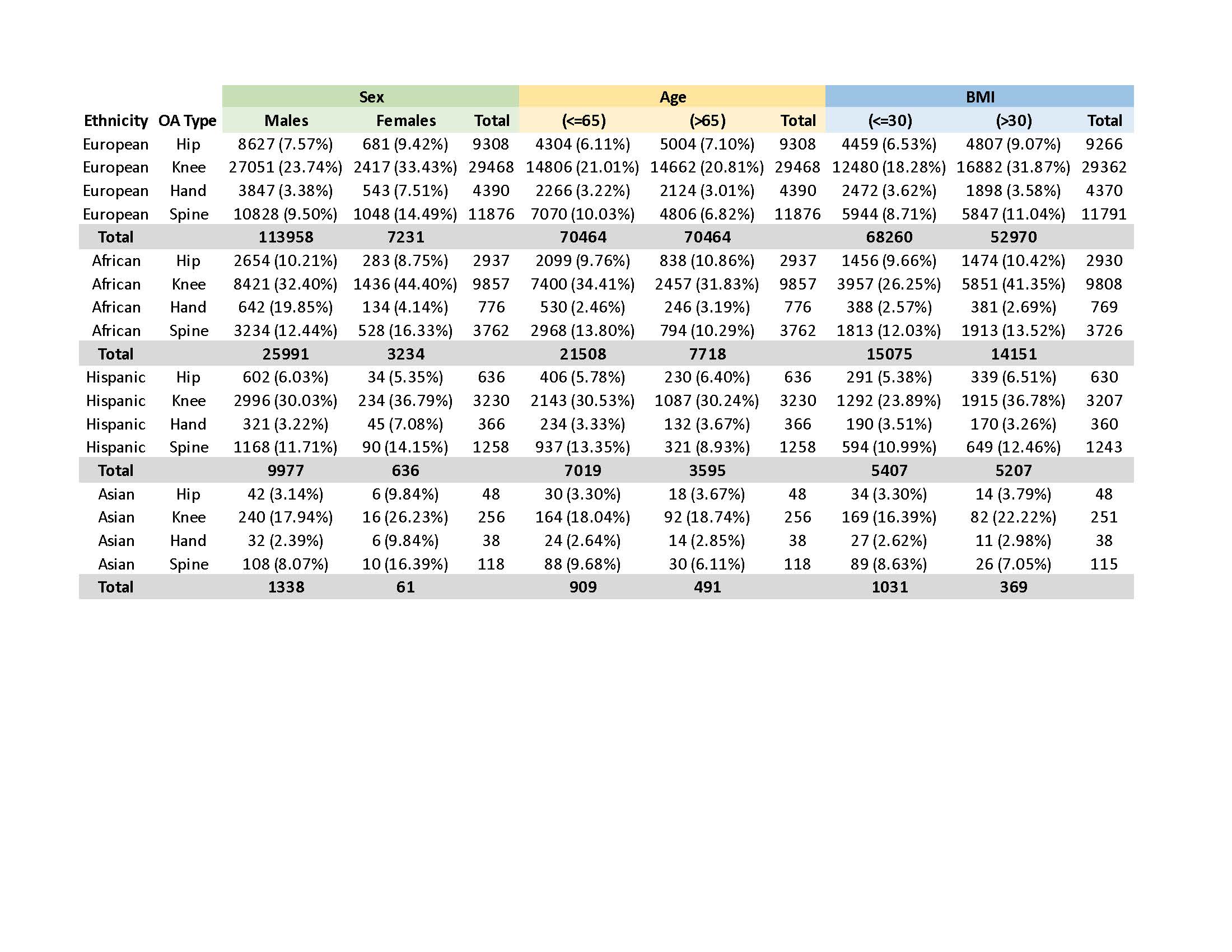Session Information
Session Type: Poster Session C
Session Time: 9:00AM-11:00AM
Background/Purpose: Osteoarthritis (OA) had profound impacts on societal and patient-centered outcomes, including disability. As the first step to leverage the rich resource of the Million Veterans Program (MVP) to examine genetic variants for OA in a large, ethnically diverse cohort, we implemented to characterize OA using data collected from the electronic health record (EHR).
Methods: OA cases and controls were identified using ICD9 and ICD10 codes, using data from 1990-2019. For OA case identification, lists of codes were provided for a general OA category and overlapping lists for specific subtypes of OA (Hip, Knee, Spine, Hand, Finger, and Thumb). Inclusion and exclusion lists were adapted from Zengini et al. 2018 (PMC5896734). Exclusion criteria for controls included a wide range of non-OA arthropathies. We further identified a list of codes for traumatic and post-traumatic arthropathy by examining ICD9 and ICD10 code descriptions for the string ‘trauma’ and identifying those denoting traumatic or post-traumatic arthropathy. To further increase specificity, a Veteran OA case was defined as having at least two ICD codes within an OA category at least 30 days apart, within the general OA category and/or within a subtype (e.g. Spine). Controls were identified as participants who were not OA cases and who had no codes in the exclusions list.
Results: A total of 121,229 Veterans of European, 29,225 Veterans of African, 10,613 Veterans of Hispanic and 1,399 Veterans of Asian descent had complete phenotypic and genotypic data for analyses. Using the above inclusion and exclusion criteria, the frequency of OA was 47% among Veterans of Europen descent, 58.1% among Veterans of African descent, 52.8% among Veterans of Hispanic descent and 33.1% among Veterans of Asian descent.
We found differences in prevalence of OA at various sites by sex, age and obesity (BMI >=30 kg/m2) within different ancestaries (Table 1).
Conclusion: Overall OA burden was higher in non-Caucasian Veterans, except in Asian descent, where it was lower. OA prevalence by joint varied by biological factors.
 Prevalence of OA at each site by ancestry and key biological variables
Prevalence of OA at each site by ancestry and key biological variables
To cite this abstract in AMA style:
McDonald M, Lakshman Kumar P, Srinivasasainagendra V, Richman J, Pinson S, Rocco A, Richard D, Jagadale V, Brown C, Tiwari H, Singh J, Bamman M. Osteoarthritis in the Million Veterans Program: Integrating the Electronic Medical Record with Precision Medicine [abstract]. Arthritis Rheumatol. 2020; 72 (suppl 10). https://acrabstracts.org/abstract/osteoarthritis-in-the-million-veterans-program-integrating-the-electronic-medical-record-with-precision-medicine/. Accessed .« Back to ACR Convergence 2020
ACR Meeting Abstracts - https://acrabstracts.org/abstract/osteoarthritis-in-the-million-veterans-program-integrating-the-electronic-medical-record-with-precision-medicine/
